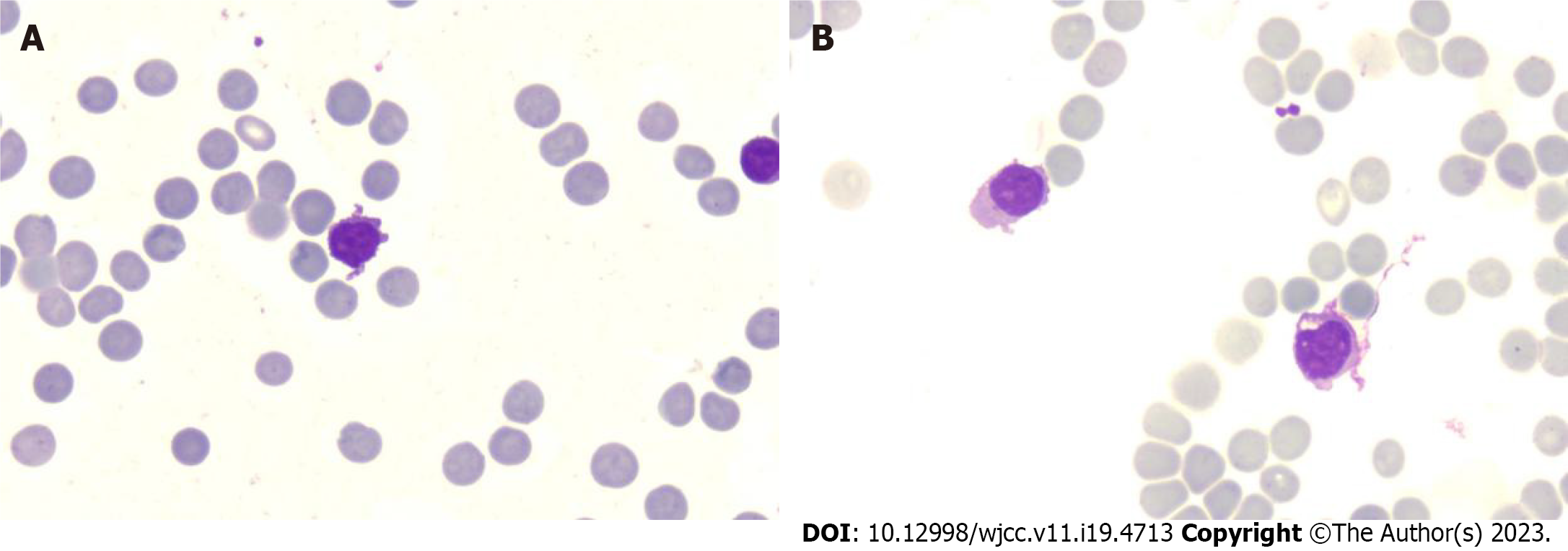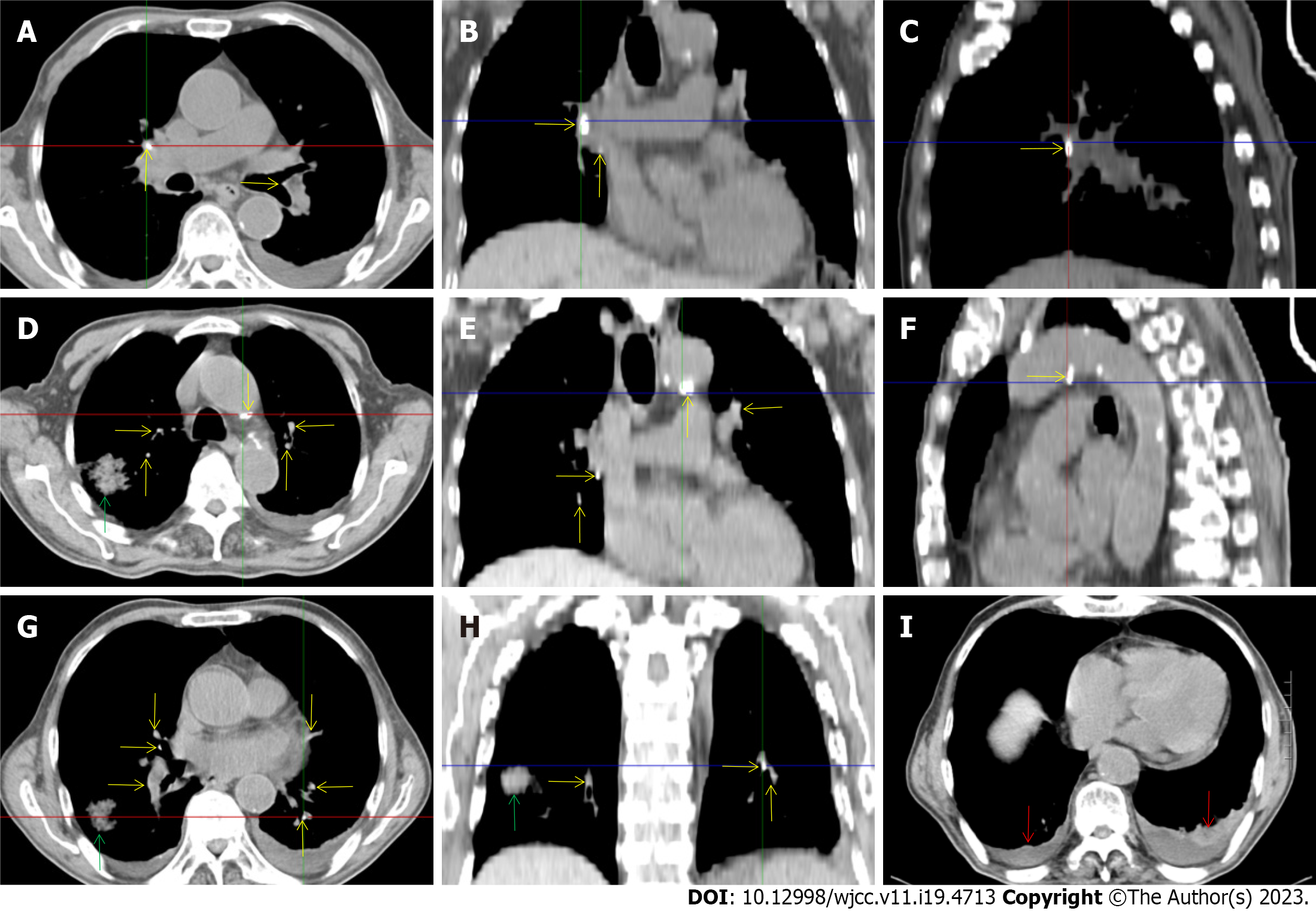Copyright
©The Author(s) 2023.
World J Clin Cases. Jul 6, 2023; 11(19): 4713-4722
Published online Jul 6, 2023. doi: 10.12998/wjcc.v11.i19.4713
Published online Jul 6, 2023. doi: 10.12998/wjcc.v11.i19.4713
Figure 1 Morphological evaluation of bone marrow and blood smears during aplastic crisis.
A: The bone marrow was aplastic, with sparsely distributed atypical lymphocytes, which accounted for 77% of all nucleated cells. The chromatin of the atypical lymphocytes was highly concentrated, the cytoplasm was excessively abundant, with eosinophilic shade on the basophilic background and most prominently adjacent to the nucleoli without visible granules, and the membrane was canthous, indicating the activation of lymphocytes. Basophilic substances were present in the cytoplasm of almost all mature erythrocytes, suggestive of dysplasia in erythropoiesis. The leukemic cells disappeared. Immunotyping analysis revealed that these atypical lymphocytes expressed a high frequency of cluster of differentiation (CD)3, CD4, CD8, CD5, CD56 and CD57, indicating the activation and expansion of autoimmune cytotoxic T-lymphocytes and natural killer (NK)/NKT cells that suppressed both normal and leukemic hematopoiesis; B: There were predominately atypical lymphocytes in the blood smears, and granulocytes were seldom visualized. Dyserythropoiesis can also be visualized in the blood smears.
Figure 2 Chest computed tomography during aplastic crisis.
A-H: Multiple calcified lesions were present in the lungs, hilum and mediastinum (yellow arrows), indicating the existence of old tuberculosis. The adjacent exudative lesions indicated reactivation of the old tuberculosis condition. A massive exudative lesion was present in the right lung (green arrows), and there was a similar exudative lesion on the pleuron adjacent to the massive exudative lesion; I: Hypertrophic lesions with pleural effusion were present in the bilateral pleura (red arrows), indicating pleural involvement of the tuberculosis infection. The pleural effusion was bloody, with an elevated level of adenosine deaminase, which was detected in aspirates and reinforced the diagnosis of tuberculosis.
Figure 3 Abdominal computed tomography during aplastic crisis.
A-E: The wall of the distal ileum was hypertrophically thickened and adhered, and the lumen of the terminal ileum was collapsed (yellow arrow). The lumen of the proximal small intestine was filled with liquid, with several gas—liquid levels. Hypertrophic lesions were also present in several segments of the colon (red arrows), and the lumen of the colon was dilated. In other segments of the colon, the wall showed fibrotic thickening. Notably, panabdominal silt-like fat proliferation led to widening of the bowel loop, forming the so-called “creeping fat sign” and indicating the presence of active chronic gut inflammatory conditions in the small intestine; F-I: In the right iliac fossa, there was an effusive lesion (purple arrow), indicative of peritoneal involvement. A gas—liquid level was present in the distal ileum (green arrows), proximal to which the ileal wall showed hypertrophic thickening (white arrows). The wall of the bladder also showed hypertrophic thickening, with an exudative lesion outside of the hypertrophic bladder wall (blue arrows). An adhered bowel loop was present in the proximal ileum (orange arrows), with the fibrotic thickening of the peritoneum forming the so-called “abdominal cocoon”. These imaging features, together with the imaging features on chest computed tomography, suggested a diagnosis of tuberculosis infection involving the gastrointestinal tract, peritoneum and urinary tract.
- Citation: Sun XY, Yang XD, Xu J, Xiu NN, Ju B, Zhao XC. Tuberculosis-induced aplastic crisis and atypical lymphocyte expansion in advanced myelodysplastic syndrome: A case report and review of literature. World J Clin Cases 2023; 11(19): 4713-4722
- URL: https://www.wjgnet.com/2307-8960/full/v11/i19/4713.htm
- DOI: https://dx.doi.org/10.12998/wjcc.v11.i19.4713











